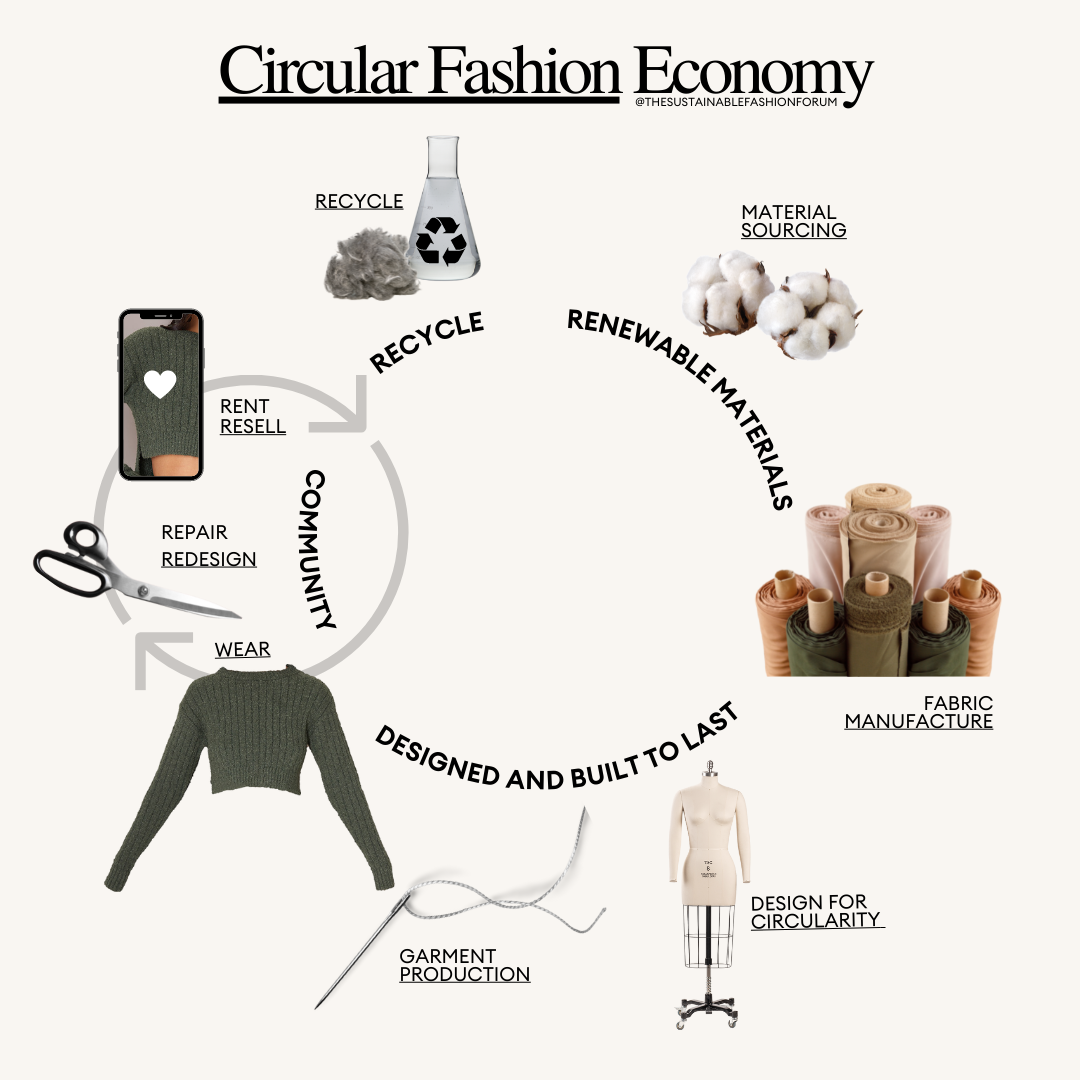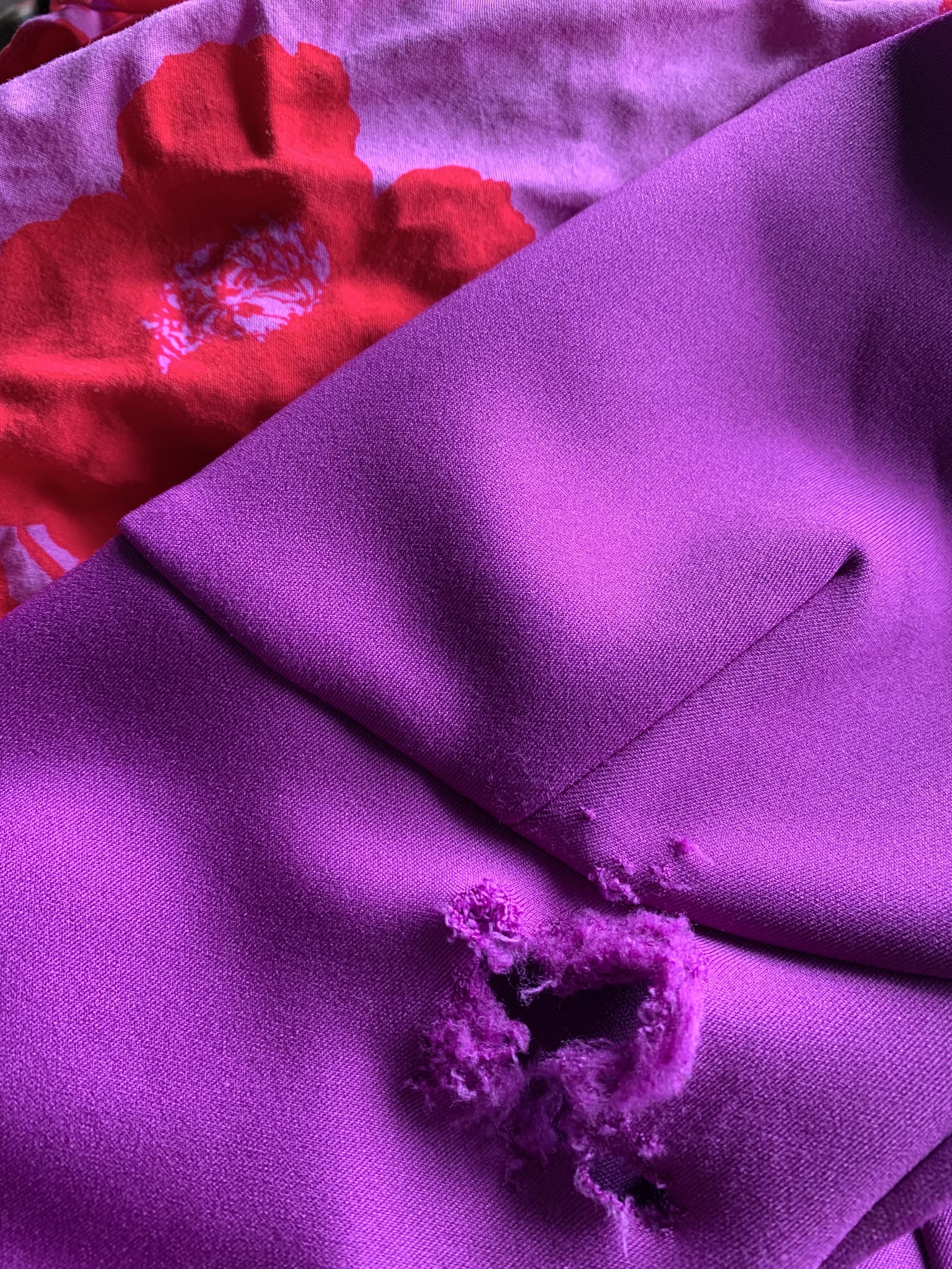What is Circular Fashion?
Welcome to Quick Question, a series where we unpack the sometimes confusing topics that are often discussed but not always explained in sustainable fashion. Have a Q? Submit your burning question to hello@thesustainablefashionforum.com to be featured on SFF.
“Make fashion circular.”
“The future of fashion is circular.”
Whether you’re new to the sustainable fashion space or are a seasoned vet, chances are you’ve heard someone in the industry make one (or both) of these statements, but what do they mean? What is circular fashion, and why is it the future?
Fashion's Current System
The current fashion model operates linearly, prioritizing the mass production and consumption of clothing and footwear, mostly made from fossil fuel-based synthetics that aren’t designed to be reused or recycled.
The continuous cycle of overproduction and overconsumption within this linear system is fueled by aggressive marketing, omnipresent advertising, and the persuasive power of influencers. This creates a culture of impulsive purchasing, enticing consumers with the allure of low prices and the promise of bolstering their sense of personal identity and social acceptance. The linear model significantly contributes to textile waste by encouraging the disposal of clothing and footwear after minimal use or when trends shift. Consequently, these items often end up in landfills, get incinerated, or are sent to developing nations, resulting in numerous environmental and social complications.
Recognizing the pressing threat of limited resources and growing consumer concerns about environmental and social impacts, the fashion industry is shifting towards a circular economy.
What is a Circular Economy?
A Circular Economy is an economic model, rooted in Indigenous principles, designed to minimize waste and make the most of resources. It's a departure from the traditional linear economy, which follows a “take-make-dispose” pattern, where resources are extracted, used to create products, and then discarded as waste.
In a Circular Economy, the goal is to keep resources in use for as long as possible, extracting the maximum value from them while in use, and then recovering and regenerating products and materials at the end of their service life. This model emphasizes three key principles:
Design for Longevity and Reusability: Products are designed to be durable, easily repairable, and recyclable or reusable at the end of their life cycle.
Resource Efficiency and Regeneration: Emphasis is placed on using resources more efficiently, reducing waste generation, and promoting recycling, remanufacturing, and refurbishment to regenerate materials and products.
Closed-Loop Systems: The aim is to create closed-loop systems where materials are continuously cycled back into the economy, reducing the need for new resource extraction.
Circular fashion refers to an approach within the fashion industry that aims to create a closed-loop system, reducing waste and maximizing the lifespan of clothing and textiles. It aligns with the principles of the Circular Economy by rethinking how garments are designed, produced, used, and disposed of.
Key aspects of circular fashion include:
Design for Longevity and Durability: Garments are designed to be durable, timeless, and high quality, encouraging longer lifespans and reducing the need for frequent replacements.
Materials and Production Methods: Emphasis is placed on using sustainable and eco-friendly materials, incorporating recycled or upcycled fabrics, and employing production methods that minimize waste and environmental impact.
Extended Use and Reuse: Circular fashion encourages clothing rental, resale markets (such as second-hand stores or online platforms), and clothing swaps to extend the life of garments beyond a single owner's use.
Repair, Remake, and Recycling: Promoting repair services, encouraging consumers to mend or alter garments, and facilitating recycling or upcycling of old clothes into new products are vital elements of circular fashion.
Closing the Loop: Creating systems where garments can be fully recycled or biodegrade at the end of their life cycle, minimizing landfill waste and allowing materials to be reused in new clothing or other products.
Embracing this approach means endless reuse and recycling, reducing waste, pollution, and reliance on new raw materials. This shift offers a transformative solution to the fashion industry's challenges like climate change, pollution, and waste, while fostering responsible growth offering opportunities for innovative business models and fostering a more environmentally conscious consumer culture.
The Journey to Circular
Achieving a circular system in fashion involves a comprehensive approach that encompasses various stakeholders, from designers and manufacturers to consumers and policymakers. From groundbreaking developments in textile recycling to digital product passports and game-changing bio-based materials, achieving an industry-wide circular business model is a lofty ambition. It will take large-scale innovation and significant funding to decouple the industry from the current growth-based model.
Design for Circularity
While there's no industry standard for what constitutes a circular product or agreed-upon definition for the baseline criteria, we know that to enable a circular economy products need to be:
Used Long Term and Durable: Designing products to last longer not only reduces the frequency of replacements but also minimizes overall resource consumption and waste generation. This involves using high-quality materials and robust construction methods to ensure longevity.
Made to be Remade: Prioritizing recyclability means designing products with materials that are easy to disassemble and process into new materials at the end of their life cycle. It involves choosing materials that have minimal environmental impact and can be recycled or reused efficiently.
User-Centric in Design: Designing products with the end-user in mind involves creating items that resonate with consumers on an emotional level, ensuring they have an enduring aesthetic appeal. Additionally, incorporating user-friendly repair options and making spare parts readily available encourages consumers to extend the lifespan of products.
Repairable: Constructing products with easily repairable components and providing accessible repair services or guidance empowers consumers to maintain and repair items, prolonging their usefulness and reducing the likelihood of premature disposal.
Brands also have a role in educating consumers about the value of durability, repairability, and responsible consumption. Providing guidance on how to care for products, offering repair tutorials or workshops, and ensuring easy access to spare parts contribute to a more sustainable consumption pattern.
Scale Textile Recycling Operations
Today, recycling textiles into new textiles at scale is a major challenge. According to the Ellen MacArthur Foundation, less than 1% of fiber used to produce clothing is recycled to make new clothing. Garments that are recycled are mainly downcycled (recycling something so that the resulting product is of a lower value than the original item) into items like insulation, mattress stuffing and industrial wipes, which surprise, surprise, ultimately ends up in the landfill. In addition to products needing to be designed for recycling, significant long-term investment and collaboration are needed to scale the collection, sorting, and recycling operations.
Scale Circular Business Models
Circular business models that allow companies to make revenue without making new clothes present significant opportunities for the fashion industry to decouple revenue from raw material production. These business models include rental, repairs, resale, and remaking (restoration, repurposing, disassembling) and offer revenue, cost benefits, and provide better product margins and competitiveness.
In striving towards a circular fashion economy, the industry stands at a pivotal crossroad. Embracing the principles of circularity—designing for durability, encouraging reuse and recycling, scaling textile recycling operations, and adopting innovative business models—offers a transformative path forward. It's a journey that demands collective commitment, innovation, and a fundamental shift in how we perceive, create, and consume fashion. By reimagining the lifecycle of clothing, prioritizing sustainability, and fostering a culture of conscious consumption, the fashion industry can not only mitigate its environmental impact but also pave the way for a future where style harmonizes with responsible stewardship of our planet’s resources.









